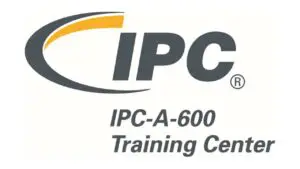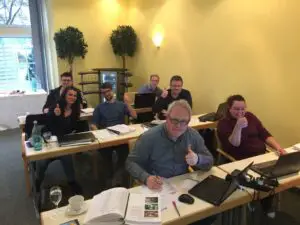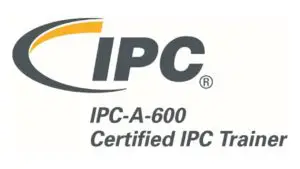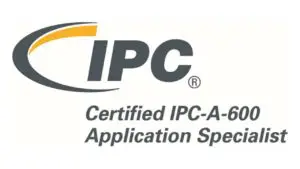IPC-A-600 Training and certification
This training is based on the document IPC-A-600 and in this document we find the inspection criteria for printed circuit boards, the so-called PCBs (Printed Circuit Boards). If a printed circuit board supplier has made a printed circuit board, it will be inspected before delivery to see if it meets the requirements and whether it shows no errors. That is what is broadly discussed in this document and in this training. A distinction is made in the IPC-A-600 between things that I can see from the outside on printed circuit boards that are delivered to the customer straight away. This is done with a visual inspection, possibly with a magnifying glass or microscope.
Furthermore, the connections and the printed circuit boards are also examined, e.g. a so-called microsection (sleeve) in which a part of the printed circuit board is generally a part of a test coupon, a specially made piece from the printed circuit board production, whereby internal checks are made as to whether the structure of that printed circuit board is as it should be and if there are no errors in the printed circuit board that should not be there. All this in the context of wanting to deliver a high-quality product and a product that meets the requirements and on which later the assembly can take place. Furthermore, a number of tests that can be carried out are discussed here, including tests for solderability, a purity test to see whether any contaminants are left on the printed circuit board that should not be present. This is broadly what is covered in this training.

PB FABRICATION
The IPC-A-600 training is suitable for the following target group:
First of all, this training is important for the inspectors who must carry out the inspection on the so-called bare printed circuit boards. This can be, for example, a final inspection before the print is delivered or a process-accompanying inspection in between.
Or employees conducting inspections on so-called test coupons where actually a little more detail is viewed inside the printed circuit board to see if the structure is good and if there are no errors that should not occur. This course is intended to train employees to do these inspections.
PB FABRICATION
The IPC-A-600 training is interesting for employees of different companies.
This training is intended for people who work as inspectors at suppliers of printed circuit boards (PCB suppliers) and the training is mandatory for this. But this training is also interesting for the people who do the incoming inspection, the so-called assemblers, who use the printed circuit boards to build their assembly.
Circuit boards are present in every electronic product, whether it is consumer electronics, industrial electronics, electronics in the automotive industry, medical equipment, aviation, space travel, satellites, etc.

PIEK: Your knowledge provider for the electronics industry

Application of the IPC-A-600 training in companies.
The IPC-A-600 training teaches you to correctly inspect bare printed circuit boards. You learn what the tolerances are, what is and what is not allowed and to be able to apply this knowledge accurately at a particular time.
The advantage for companies is that people learn what is and what is not allowed and what they can let pass. That means that people are confident in making decisions and that less waste is produced because people know what is and is not produced according to the requirements. This is the ultimate goal of this training.
The added value of IPC-A-600 Training and certification.
The added value of this IPC-A-600 training lies in the fact that the inspectors, but also other employees, have knowledge of the requirements and knowledge of the tolerances and can make decisions whether or not a printed circuit board meets these requirements.
This means that on the one hand you will have less waste because products will not be thrown away and on the other hand there is no risk that a product will be delivered that does not meet the requirements. On the one hand this saves some costs and on the other hand there is no loss of face, no loss of customers because you delivered a bad product.

Validity of the IPC-600 certification
If you have not previously been certified for the IPC-600 or your certificate has expired, you will need the initial IPC-600 certification. This has a validity of 2 years.
You must recertify within 6 months before the certificate expires. You have the following options for recertification:
- IPC-600 Recertification: full training for recertification
- IPC-600 Challenge Test: only the exam
- IPC-600 Refreshment of the Standard + Challenge Test
Variant of the IPC-600 certification
IPC-A-600 CIS (Certified IPC Specialist)
This IPC-A-600 Certified IPC Specialist (CIS) variant is intended for operators
IPC-A-600 CIT (Certified IPC Trainer)
This IPC-A-600 Certified IPC Trainer (CIT) variant is intended for anyone who wants to train operators to CIS themselves
IPC-A-600 CSE (Certified Standards Expert)
This IPC-A-600 Certified Standard Expert (CSE) variant is intended for anyone who wants to become an expert in the field of the relevant standard. These experts are often used by companies as coordinators to correctly apply the standard within the company.
Upcoming regional IPC-A-600 training courses
| Start date | Training | Language | Location | |
|---|---|---|---|---|
| 08 September 2025 | ONLINE IPC-A-600 | German | ONLINE | Quote Request |
| 15 September 2025 | ONLINE IPC-A-600 | English | ONLINE | Quote Request |
| 01 December 2025 | IPC-A-600 | German | Bretten | Quote Request |
| 08 December 2025 | IPC-A-600 | English | Heerlen | Quote Request |
Frequently Asked Questions
This is a test method that allows you to “measure” how long it takes for a drop of solder spreads onto the surface. This test is often performed in a lab on PCBs, components, terminals, wires, contacts, etc.
Yes, this repair procedure is described in the IPC-7711/7721 standard. The maximum size of a delamination depends on the product class. This is described in the IPC-A-600, the IPC-A-610 and IPC-6012 standard.
Yes that is possible, for more information: https://piektraining.com/en/online-training/
The IPC-A-600 training is a theory training.
FOD is the abbreviation for “Foreign Object Debris” and means contamination by foreign objects (fluff, hair, material residues) on the surface. This abbreviation is often used in the IPC-A-600, IPC-A-610, IPC-6012 and contradicts “Foreign Object Damage” (FOD) which is often used in aircraft (and aerospace) products.
This is described in the IPC-A-600. The number depends on the product class.
The IPC-A-600 and the IPC-A-610 describes how much a conductor may be damaged maximum in width. This damage depends on the product class and is indicated in %.
AABUS is the abbreviation of “As Agreed Between User and Supplier”. This abbreviation often occurs in an IPC standard.
Yes, the repair procedure is described in the IPC-7711/7721. The maximum contamination of gold-plated edge contacts is described in the IPC-A-600 and the IPC-A-610 standard.
Yes. This is explained in the IPC-6012 training and also in the IPC-A-600, IPC-A-610 and J-STD-001 training program.
Nailheading is described in the IPC-A-600 standard. The internal layer of a multi-layer printed circuit board is shaped like a nailhead. This is caused by the manufacturing process.
Yes, IPC has made a product classification in every standard, including the IPC-A-600.
This product classification is as follows:
- IPC-A-600 Class 1 – General electronic products (e.g. consumer electronics, these are products where the main requirement is the function of the final product)
- IPC-A-600 Class 2 – Dedicated service electronics (e.g. industrial machines, test equipment, etc. these are products that have to work longer, if they fail, a lot of money will be lost)
- IPC-A-600 Class 3 – High reliability electronics (e.g. aircraft, military products and life-supporting medical equipment, these products may not fail otherwise it is life-threatening).
The IPC-A-600J version (from May 2016)
IPC has 3 product classes: class 1 (consumer electronics), class 2 (industrial electronics) and class 3 (high reliability electronics). The customer may determine the product class in which the product must be produced. It is important that the inspector knows according to which product class of IPC he must inspect, because otherwise too many products will be unnecessarily rejected!
The IPC-A-600 and the IPC-A-610 describe how much an pad/land may be lifted.
